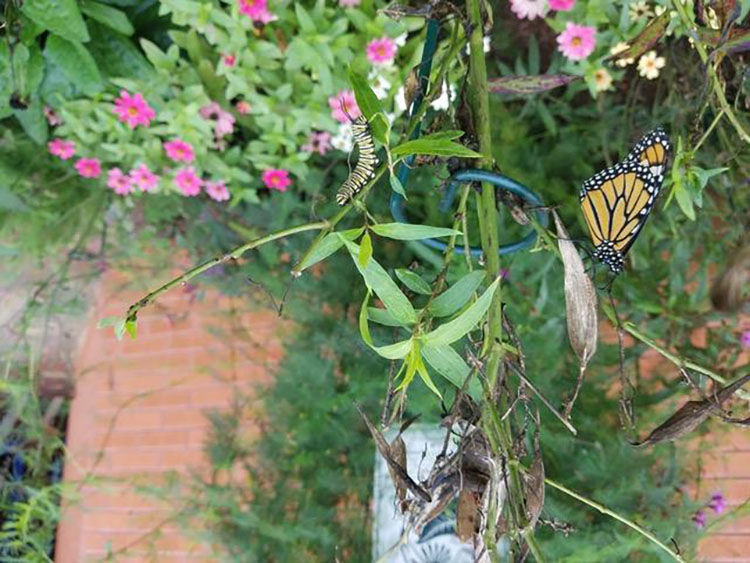By Gretchen C. Van Benthuysen |
How many monarch butterflies did you see along the East Coast during this year’s annual migration from New England to breeding grounds in Mexico?
The orange-colored insects, weighing less than a postage stamp, usually pass through coastal New Jersey mid-to-late September on their approximately 2,500 mile trek.
Some years are better than others, but according to the National Wildlife Federation, the monarch butterfly population has declined by 90 percent in the last 20 years. Their numbers went from an estimate of a peak of a billion in 1996-’97 to a low of 50 million 2012-’13.
And we have only ourselves to blame.
- Various organizations that monitor monarchs point to the following for the decline:
- Herbicide-based agriculture destroying milkweed and nectar plants
- Fragmentation and loss of habitat due to real estate and agricultural development
- Illegal logging of oyamel fir trees in Mexico where the monarchs overwinter
- Climate change causing severe weather harmful to the insects and their habitat
(Monarchs east of the Rocky Mountains follow several flyways that merge into one in central Texas. West of the Rockies, they fly south to California along the Pacific coast and overwinter near Santa Cruz and San Diego.)
But we humans also can make a difference and help them get back on their feet, so to speak, by creating Monarch Waystations in our yards, communities, schools, and along highways and byways, by planting milkweed and nectar plants.

The waystation project was created by MonarchWatch.org, a nonprofit education, conservation, and research program based at the University of Kansas. Its website lists thousands of stations across the U.S., including some in Little Silver, Atlantic Highlands, Rumson, Middletown and one at the Monmouth Museum on the Brookdale Community College campus.
All monarchs — including those in the Caribbean, Central and South America, Australia and New Zealand — need milkweed to survive. It’s the only plant adult butterflies lay their eggs on because it’s the only thing baby caterpillars eat when they hatch.
Pat Mahon, Shrewsbury, and Penny Raffetto, Neptune, both Rutgers Master Gardeners of Monmouth County since 2012, are part of the team that developed and maintains a certified waystation behind the Monmouth County Agricultural building, 4000 Kozloski Road, Freehold.
In 2013 they created a nearby rain garden. A year later, Pat Eisemann, Manalapan, also a Master Gardener who grew up on an 80-acre farm in Freehold Township, suggested they add native milkweeds (New Jersey has three) and nectar plants to qualify as a waystation.
“We did, and often saw lots of butterflies flying across the parking,” Mahon said.
In 2015, Eisemann asked them to establish a dedicated Waystation.
They began with plugs of common milkweed (Asclepias syriaca), that fall, Mahon explained.
“In the spring of 2016 we added swamp milkweed (Asclepias incarnata) and seeded the garden to provide nectar sources,” she said.
During a recent garden visit, all four life stages of a monarch butterfly were observed: eggs on a leaf, a caterpillar munching milkweed, emerald green chrysalises (pupas) attached to the agricultural building’s brick walls and beneath a picnic table, and a new adult drying its wings.
The gardeners plan to add perennials and host plants to attract the Black Swallowtail, the New Jersey State Butterfly, and the Painted Lady to the garden.
“People plant a butterfly bush to attract them, but that’s like giving them cotton candy and they can’t do anything with that,” Raffetto said. “If they’re in your garden, why aren’t you doing something for their whole cycle?
“If you plant a garden that’s balanced with the things they need they will come,” she said. “It only took two years to really get ours going and this year has been the most active with lots of butterflies and caterpillars.”
All three gardeners warn that helping monarchs thrive is addicting.
“I told my husband that less than 1 percent of all the eggs the butterfly lays makes it through the whole cycle,” Mahon said. “Now he studies the garden and brings in the baby caterpillars to an enclosure we built on the screened-in porch and feeds them milkweed leaves to survive.”
They released 16 butterflies last month.
Eisemann calls the late summer monarchs the “super generation.” They fly, only by day, to winter over in Mexico. The females return to the southern United States in the spring, mate, deposit their eggs, and die. They are followed by two or three short-lived – two to five weeks – generations that head north and repopulate. Then the cycle begins again.
“Many people are helping, but don’t bother to register their garden,” Eisemann said. “Lots of teachers are adding it to their curriculum.”
The Rutgers Master Gardeners and the Monarch Teacher Network co-sponsor an annual two-day seminar “Teaching and Learning With Monarch Butterflies” at the agricultural building open to all. The next one is scheduled for Aug. 19-20 at the Agricultural Building.
Also, the annual Master Gardeners’ Spring Garden Days sale scheduled for May 10-11 sells milkweed and pollinator plants.
Meanwhile, the Rutgers Master Gardeners’ office is staffed weekdays. Call 732-303-7617 for advice on waystations and other gardening issues or visit for free handouts that include lists of butterfly host and nectar plants, local milkweeds, native plants, and the Monarch Waystation how-to brochure.
This article was first published in the Oct. 4-10, 2018 print edition of The Two River Times.














